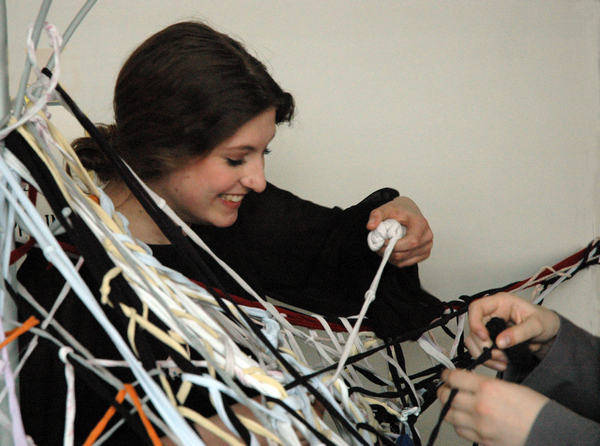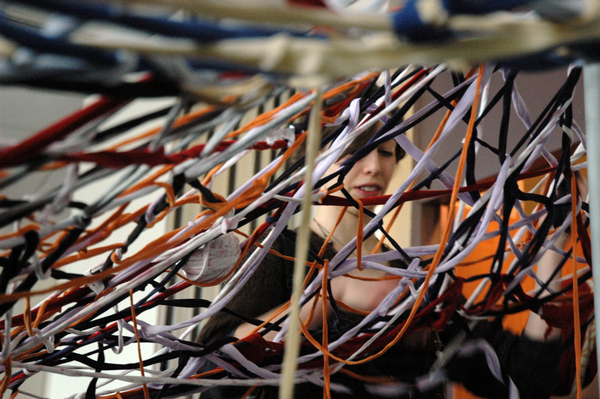Promised Eveline to be on the lookout for play stuff - moments of free-form play…
Algorithmic approach and free-form play

Went to a symposium about PLAY the other day, organised by Artez art school. Eveline and me promoted playart.nl and I got to try out the make-a-spiderweb idea that surfaced during the knitting workshops in The Hague, check here.
How come people can speak about play & do games and still be boring? The whole day had a very stilted quality – only moment of playfulness I noticed was when people started throwing my yarn about. This activity was quickly ended by the symposium organisation as being Too Dangerous. It was the algorithmic approach prevailing again!
Below the text I published earlier about algorithms and structures of thought.
( Note: game-cum-publication works under IE and Firefox, not under Chrome – find out why! Later: found out why and corrected the algorithm. )
“The way computer games teach structures of thought – the way they reorganize perception – is by getting you to internalize the logic of the program. To win, you can’t just do whatever you want. You have to figure out what will work within the rules of the game. You must learn to predict the consequences of each move, and anticipate the computer’s response. Eventually, your decisions become intuitive, as smooth and rapid-fire as the computer’s own machinations”(1).
“In mathematics, computer science, and related subjects, an ‘algorithm’ is an effective method for solving a problem expressed as a finite sequence of instructions. Algorithms are used for calculation, data processing, and many other fields”(2).
The subject of how games effect players’ behaviour – and their minds – permeates this essay. This unit discusses the way a game teaches its players algorithmic behaviour. Algorithms – both the human and the computational kind – consist of a series of instructions for sorting, ordering, classifying and judging objects, actions and people.
An example of the human kind: Sophie Calle, who seems to be unable to handle life unless she can apply some rule to it. This can be traced in almost all of her work – it has an algorithmic quality. Take for example ‘The Gotham Handbook’ (1998), where Calle followed a receipe for her behaviour set out by filmmaker Paul Auster. He challenged her to adopt, beautify and maintain a public amenity in New York. Calle adopted a telephone booth, decorated it, cleaned it and used it as a base to hand out smiles, cigarettes, sanwiches & suchlike. Her documentation reflects her algorithmic approach: she lists the number of smiles given, the number of smiles received, the number of sandwiches and cigarettes handed out & cet & cet.
Another example, this one closer to computer code: Lawrence Weiner. In Dicht Bij or Close By (BAK, Utrecht, jan-march 2010). Weiner exhibited works that are interpretable as being algorithms. Weiners works were printed on the wall as diagrams dealing with power structures and masses and how these interact.
Games prescribe actions: human activities are coded so they fit into the game. Video games provide a strong algorithmic structure: the game controller provides the physical vocabulary for humans to use. Hand movements correspond to actions in the world of the game, causing reactions which in turn ask for player action. To learn how to play a game is to learn to operate within an algorithm.
So this is what the game teaches players: to pass messages from object to object inside the game’s environment. The objective is to develop the player to a point where he is autonomous and competent within the environment, providing him with options and guiding him towards a pre-defined set of actions.
Games give clues as to the fundamental transformation into informatics that is affecting society. Words like ‘active’ and ‘non-linear’ suggest that games have liberating qualities – which indeed they have. To be a player in the ‘game of art’ is to be both more involved with and more influential in shaping the work of art than ever before. But simultaneously, a game may exist as a new kind of manipulation, using embedded, invisible algorithms to command and control.
(1) Ted Friedman, Civilization and Its Discontents: Simulation, Subjectivity, and Space http://www.duke.edu/~tlove/civ.htm
(2) Wikipedia
| « Collecting Contemporary – thingyness and thin air | <-- previous post | next post --> | The relevance of the beautiful » |
|---|










